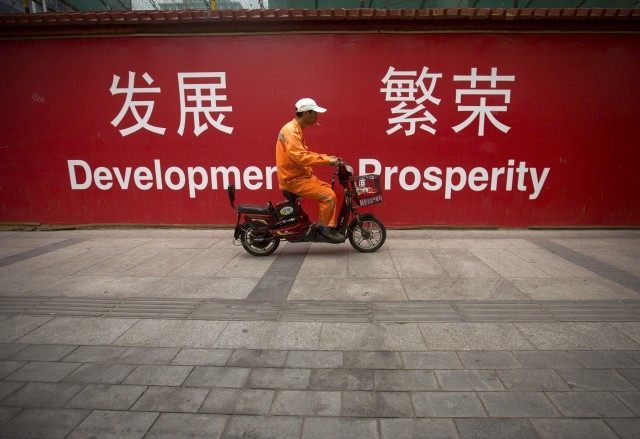With China’s foreign exchange reserves falling by $490 billion in the last twelve months, China is on pace to run out of currency reserves in just two years.
Following Chairman Mao Zedong’s death, exports as a share of China’s gross domestic product rose between 1979 and 2007 from less than 6 percent to nearly 36 percent–more than three times the ratio in the United States, twice that in Japan, and on a par with that in Germany. But it is now obvious that China has finally undermined the competitiveness of its coastal low-cost manufacturing base, according to Stratfor Global Intelligence.
Stratfor estimates China’s economy today compared to the U.S. is 60 percent as large; per capita income is 13.9 percent as large; the labor force is 503% larger; exports are 21 percent bigger; and imports are 17 percent less. To support its new, robust position in the world, China now spends about 31 percent as much on defense as the U.S. military.
The secret to China’s spectacular growth spurt was the demographic stimulus of moving about 300 million workers from the impoverished interior to work as migrants along the nation’s coastal manufacturing centers that overwhelmingly focus on exporting manufactured goods. That is just under twice the size of the entire U.S. workforce.
Stratfor highlights:
Chinese leaders readily acknowledged the limits and risks inherent to the country’s export-oriented economic growth model. They understood that rising rates of urbanization, education levels and costs of living in coastal cities would eventually–despite formal and informal government efforts to keep costs low–undermine the competitiveness of coastal China’s low-cost manufacturing base.
But this same spectacular demographic achievement became a liability once the 2008-2009 global economic crisis hit. Due to inflation and competition from a number of cheaper labor sites, like Vietnam, China’s competitiveness as the world’s factory is over.
The financial crisis forced China “to accelerate the process of moving from an economic model grounded in the systematic repression of private household consumption (by maintaining artificially low wages and input costs) to one grounded in the expansion of domestic consumption,” according to Stratfor.
China’s leaders now talk about developing a high value-added and consumption-driven services sector, and pushing manufacturing up the value chain, as critical to continue double digit growth.
But with a per capita income of $7,594, ranked seventieth in the world, most Chinese have no ability to be the consumers for what the supposedly New China wants to sell. Furthermore, pushing manufacturing up the value-chain also involves much greater commitment to the type of capital equipment that undermines high rates of employment.
Rather than making real structural changes, China went on a borrowing and building spree to keep employment up. Debt quadrupled from $7 trillion in 2007 to $28 trillion in 2014, according to McKinsey Economic Insights. At 282 percent of GDP, the debt is larger than that of the U.S. and Germany. The most dangerous developments are that half of all loans are linked in some fashion to the over-heated real estate market. Unregulated shadow banking now accounts for nearly half of all new lending, and the debt of many local governments are unsustainable.
Most analysts believe that the $4 trillion in foreign exchange reserves China had at this time last year would provide the capability to bail out its leveraged economy. But the People’s Bank of China just announced that China’s currency reserves fell for the fifth straight month by $43.3 billion in September, after falling $93.9 billion in August, according to a Wall Street Journal article.
That means that China’s official reserves fell by a least a stunning $490 billion to $3.51 trillion in just the last twelve months. Given the nation needs at least $2.5 trillion to support its huge export/import sector, China will effectively be out of excess foreign exchange reserves in just two years.
Countries normally devalue their currency to restore competitiveness. But the Bank of International settlements estimates that dollar denominated loans at Chinese banks are over $1.1 trillion, and shadow banking loans denominated in dollars are up to $5 trillion. When China devalued its currency by less than 3 percent, the Chinese stock markets lost almost $4 trillion in market value.
China has lost its low-cost manufacturing competitiveness; is unable to transition to high consumption-driven economy; is spending huge amounts of dollars trying to prevent another financial crash; and is running out of foreign reserves quickly, according to Stratfor.

COMMENTS
Please let us know if you're having issues with commenting.